Seasonal Contributions and Influencing Factors of Urban Carbon Emission Intensity: A Case Study of Tianjin, China
Abstract
1. Introduction
2. The Literature Review
3. Methods and Data
3.1. The Research Methodology
3.1.1. Calculation of Carbon Emission Intensity
3.1.2. The Decomposition of Influencing Factors
3.2. The Data Sources
4. Results and Discussion
4.1. An Annual Analysis of Carbon Emission Intensity
- (1)
- Economic Development
- (2)
- Industrial Structure
4.2. A Quarterly Analysis of Carbon Emission Intensity
4.3. A Decomposition Analysis of the Factors Affecting Quarterly Carbon Emission Intensity Changes
4.3.1. A Decomposition Analysis of the Factors Influencing Quarterly Carbon Emission Intensity Changes over the Years 2012–2022
- (1)
- A Decomposition Analysis of Factors Influencing First Quarter Carbon Emission Intensity Changes, 2012–2022
- (2)
- A Decomposition Analysis of the Factors Influencing Second Quarter Carbon Emission Intensity Changes, 2012–2022
- (3)
- A Decomposition Analysis of the Factors Influencing Third Quarter Carbon Emission Intensity Changes, 2012–2022
- (4)
- A Decomposition Analysis of the Factors Influencing Fourth Quarter Carbon Emission Intensity Changes, 2012–2022
4.3.2. Intra-Annual Quarterly Changes and a Decomposition Analysis of the Carbon Emission Intensity Factors, 2012–2022
5. Conclusions and Recommendations
5.1. Conclusions
5.2. Recommendations
- (1)
- Seasonal Management Strategies: Develop management strategies tailored to different seasons based on the identified seasonal variations. For example, focus on the impacts of slowed economic activities in the first quarter and promote the application of clean energy during the heating season to reduce carbon emissions from thermal power.
- (2)
- Optimize the Energy Structure: Considering the significant impact of thermal power emission effects on seasonal changes in carbon emissions, it is recommended that the government advances the optimization of the energy structure. This includes increasing the share of clean energy and reducing reliance on thermal power to effectively lower the carbon emission intensity.
- (3)
- Enhance Energy Efficiency: By increasing the negative contribution of power intensity effects, i.e., enhancing energy efficiency, the carbon emission intensity can be effectively reduced. The government should incentivize businesses and residents to adopt energy-saving technologies and equipment and promote advanced energy management systems.
- (4)
- Manage Seasonal Energy Demands: Given the impact of seasonal factors on carbon emission intensity, the government is advised to develop corresponding energy demand management measures. This policy should encourage the use of clean energy during peak carbon emission seasons.
- (5)
- Promote Economic Structural Transformation: Analysis of the economic intensity effects suggests that the government should facilitate a transition towards a low-carbon, high-efficiency economic model, develop green industries and a circular economy, and promote sustainable development.
- (6)
- Strengthen Carbon Emission Monitoring and Management: It is recommended to establish and improve a carbon emission monitoring system, regularly publish carbon emission intensity reports, and provide solid data support for policy-making and adjustments. Additionally, overall carbon emission management should be strengthened through mechanisms such as carbon trading and carbon taxes, incentivizing businesses and individuals to reduce emissions and achieve carbon reduction goals.
- (7)
- Encourage Community Involvement and Educational Campaigns: Encourage active participation from all sectors of society in carbon reduction efforts and enhance public awareness and understanding of carbon emission issues. The government could guide residents and businesses to adopt energy-saving and emission reduction measures through public education and awareness campaigns, collectively working to reduce carbon emissions.
Supplementary Materials
Author Contributions
Funding
Institutional Review Board Statement
Informed Consent Statement
Data Availability Statement
Conflicts of Interest
References
- Li, Z.-G.; Wang, J.; Che, S. Win-Win Development of Industrial Growth and Energy Conservation and Emission Reduction under the Constraint of Carbon Peaking in China. J. Environ. Econ. 2021, 6, 7–22. [Google Scholar] [CrossRef]
- Shi, Z.-T.; Qi, F. Steadily Advancing Energy Conservation and Carbon Reduction in the New Era. Red Flag Manuscr. 2023, 16, 29–32. [Google Scholar]
- Wu, Y.-Q.; Peng, Z.-S.; Ma, Q.-J. Study on the Factors Influencing Carbon Emission Intensity in the Yangtze River Delta Region. J. Liaoning Univ. Technol. (Soc. Sci. Ed.) 2023, 25, 28–34. [Google Scholar]
- Peng, C. Study on the Intensity of Industrial Carbon Emissions, Influencing Factors, and Countermeasures in Guiyang City. J. Guizhou Univ. Commer. 2022, 35, 59–70. [Google Scholar]
- Xia, Y.-S.; Sun, L.-X.; Feng, C. What causes spatial inequalities of low-carbon development in China’s transport sector? A newly proposed meta-frontier DEA-based decomposition approach. Socio-Econ. Plan. Sci. 2022, 80, 101151. [Google Scholar] [CrossRef]
- Zhao, J.; Liu, Q. Examining the Driving Factors of Urban Residential Carbon Intensity Using the LMDI Method: Evidence from China’s County-Level Cities. Int. J. Environ. Res. Public Health 2021, 18, 3929. [Google Scholar] [CrossRef]
- Wang, M.-K.; Bai, Y.-P. Decomposition Study of Carbon Emission Intensity Factors in Jiangsu Province Based on the LMDI Model. J. Ningxia Univ. (Nat. Sci. Ed.) 2022, 43, 109–114. [Google Scholar]
- Wang, K.; Tang, X.-H.; Gan, C.; Liu, H.-L. Spatial and Temporal Patterns and Influencing Factors of Carbon Emission Intensity in China’s Service Sector. China Popul. Resour. Environ. 2021, 31, 23–31. [Google Scholar]
- Wang, Y.; Zheng, Y. Spatial effects of carbon emission intensity and regional development in China. Environ. Sci. Pollut. Res. 2021, 28, 14131–14143. [Google Scholar] [CrossRef]
- Li, H.; Li, B.; Liu, H.; Zhao, H.; Wang, Y. Spatial distribution and convergence of provincial carbon intensity in China and its influencing factors: A spatial panel analysis from 2000 to 2017. Environ. Sci. Pollut. Res. 2021, 28, 54575–54593. [Google Scholar] [CrossRef]
- Hou, X.-N.; Cui, Y.-B. Statistical Measurement of Factors Affecting China’s Carbon Emission Intensity. Contemp. Econ. 2023, 40, 48–54. [Google Scholar]
- Waheed, R. The Significance of Energy Factors, Green Economic Indicators, Blue Economic Aspects towards Carbon Intensity: A Study of Saudi Vision 2030. Sustainability 2022, 14, 6893. [Google Scholar] [CrossRef]
- Zhang, C.; Zhou, B.; Wang, Q. Effect of China’s western development strategy on carbon intensity. J. Clean. Prod. 2019, 215, 1170–1179. [Google Scholar] [CrossRef]
- Sun, W.; Huang, C. Predictions of carbon emission intensity based on factor analysis and an improved extreme learning machine from the perspective of carbon emission efficiency. J. Clean. Prod. 2022, 338, 130414. [Google Scholar] [CrossRef]
- Mao, Y. Configurational conditions of national carbon intensity: A fuzzy set analysis of 136 countries. Environ. Sci. Pollut. Res. 2019, 26, 32446–32459. [Google Scholar] [CrossRef] [PubMed]
- Zheng, X.; Yu, H.; Yang, L. Factor Mobility, Industrial Transfer and Industrial Carbon Emission: A Spatial Matching Perspective. Front. Environ. Sci. 2022, 10, 822811. [Google Scholar] [CrossRef]
- Chen, T.; Li, X.-Y.; Chen, B. Decomposition and Peak Prediction Study of Factors Affecting China’s Carbon Emissions. J. Saf. Environ. 2024, 24, 396–406. [Google Scholar] [CrossRef]
- Li, W.; Meng, P.-Z.; Li, C.-D.; Yan, Z.-G. Analysis of Factors Affecting Carbon Emissions from Agricultural Production in Gansu Province and Emission Reduction Pathways Based on the LMDI Model. Crop Mag. 2023, 05, 264–271. [Google Scholar] [CrossRef]
- Fu, Y.-P.; Ma, S.-C.; Song, Q.; Gao, J. Study on the Decomposition of Carbon Emission Influencing Factors in China Based on LMDI. Pract. Underst. Math. 2019, 49, 7–17. [Google Scholar]
- Li, X.-M.; Ye, H.-J. Decomposition Study of Factors Influencing Carbon Emissions by Industry in China. Ecol. Econ. 2015, 31, 55–59+84. [Google Scholar]
- Lü, Z.-C.; Liu, Y.; Li, J.-R.; Guo, X.-M. Accounting and Analysis of Factors Affecting Energy Consumption Carbon Emissions in Hebei Province Based on LMDI. Environ. Ecol. 2023, 5, 74–78+87. [Google Scholar]
- Li, W.-H.; Li, Z.-G.; Yu, G.-H.; Liu, X.-Z.; Fu, L.-J. Analysis of Factors Influencing Carbon Emission Intensity in Hunan Province Based on LMDI Method. J. Chin. Acad. Environ. Manag. 2018, 28, 50–54. [Google Scholar] [CrossRef]
- Wang, Z.-L.; Wang, D.-D.; Qiu, S.-L. Decomposition Study of Industrial Carbon Emission Intensity Factors. Pract. Underst. Math. 2023, 53, 21–35. [Google Scholar]
- Chen, L.; Zhang, N.; Wang, Y.-F.; Hu, W.-T. Drivers and Attribution Analysis of Carbon Emission Intensity Changes in the Beijing-Tianjin-Hebei Region—From the Perspective of Subsectors and Five-Year Plans. China Environ. Sci. 2024, 08, 1–17. [Google Scholar] [CrossRef]
- Liu, J.; Ding, X. LMDI Factor Decomposition Model Study of China’s Carbon Emission Intensity—From the Perspective of Industrial Development. J. Shandong Inst. Bus. Technol. 2020, 34, 37–47. [Google Scholar]
- Sun, J.-S. Empirical Study on the Driving Factors of Carbon Emission Intensity in China. J. Guizhou Univ. Financ. Econ. 2011, 3, 1–6. [Google Scholar]
- Liang, J.; Shi, A.-N.; Zhu, H.-J. Analysis of Trends and Influencing Factors of Carbon Emission Intensity in Jiangsu Province. Nanjing Soc. Sci. 2013, 5, 143–148. [Google Scholar] [CrossRef]
- Wang, Y.-X.; Huang, H.-Q.; Chen, Y.; Dong, M.-Q.; Li, S.-W.; Yue, S.-J.; Lu, Z.-W. Analysis of Driving Factors of Carbon Emissions from Electric Power Consumption in China Based on the LMDI Decomposition Method. J. Hubei Univ. Econ. (Humanit. Soc. Sci.) 2023, 20, 38–44. [Google Scholar]
- Ma, J.-J. Who shapes the embodied carbon dioxide emissions of interconnected power grids in China? A seasonal perspective. J. Environ. Manag. 2022, 324, 116422. [Google Scholar] [CrossRef]
- Yang, P.-B.; Wang, Y.; Ma, X.-Y. Scientific Evaluation of Pollution Reduction and Carbon Reduction to Improve Pollution Control Levels. State Grid News, 23 February 2023; 5. [Google Scholar]
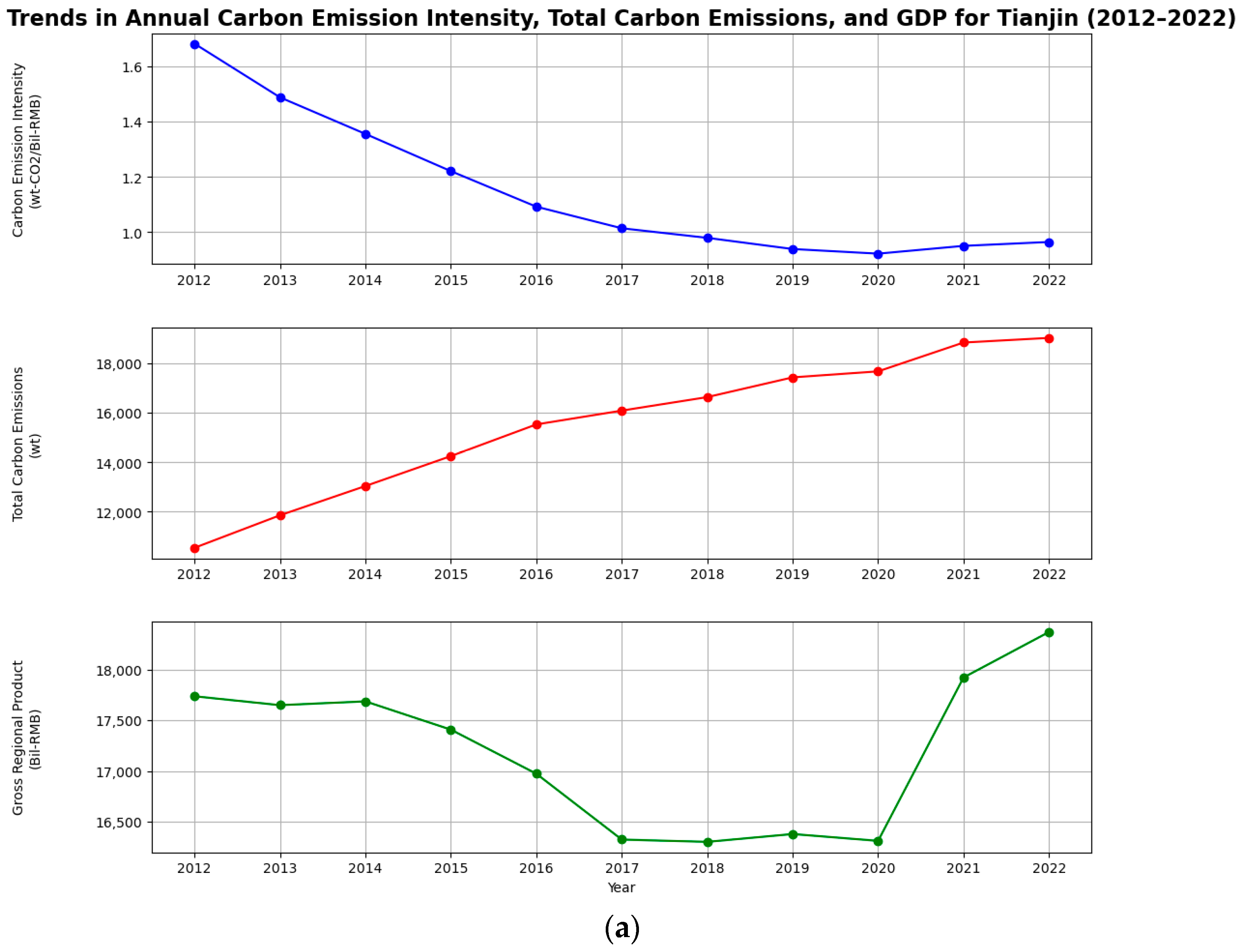


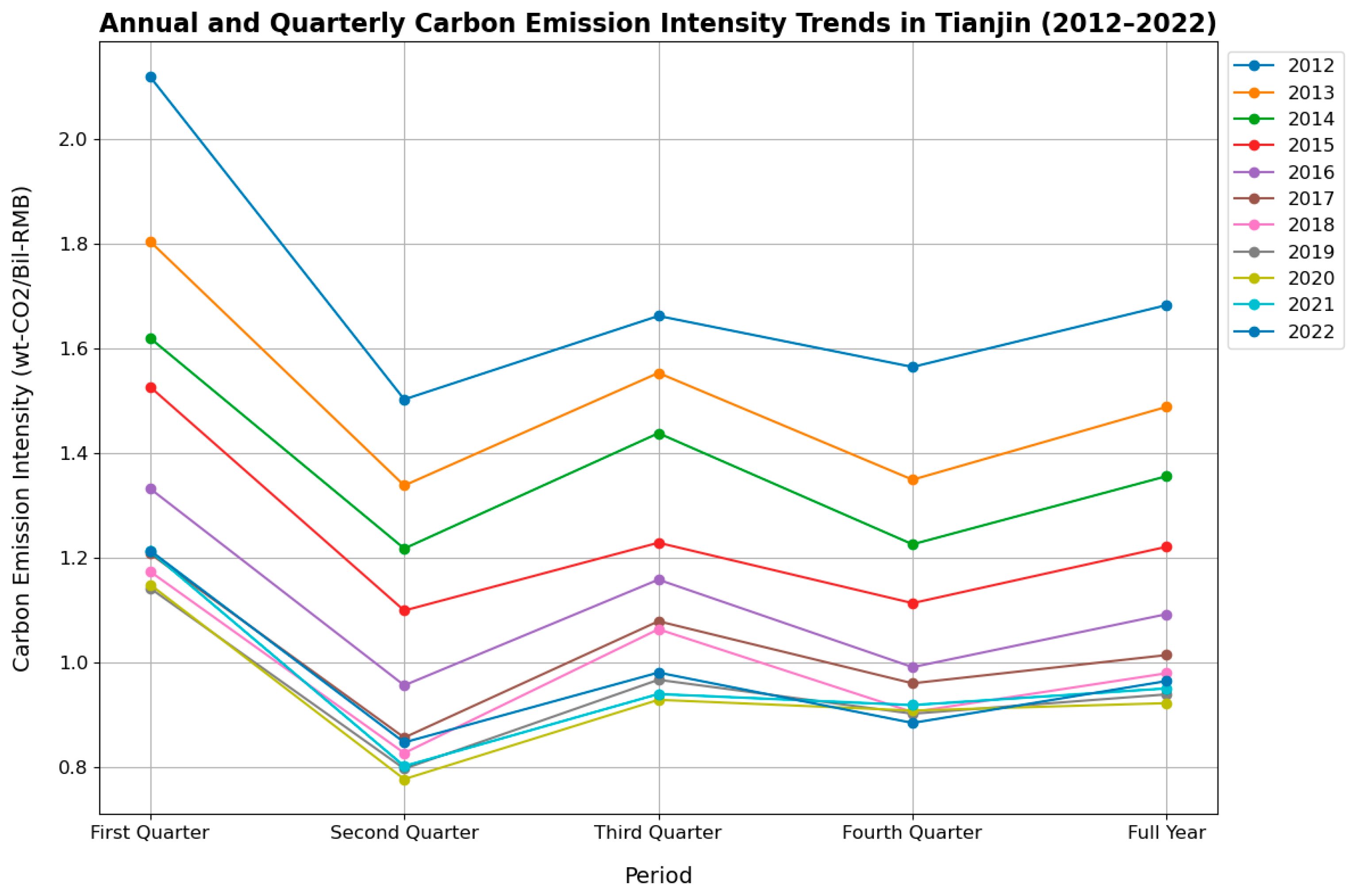


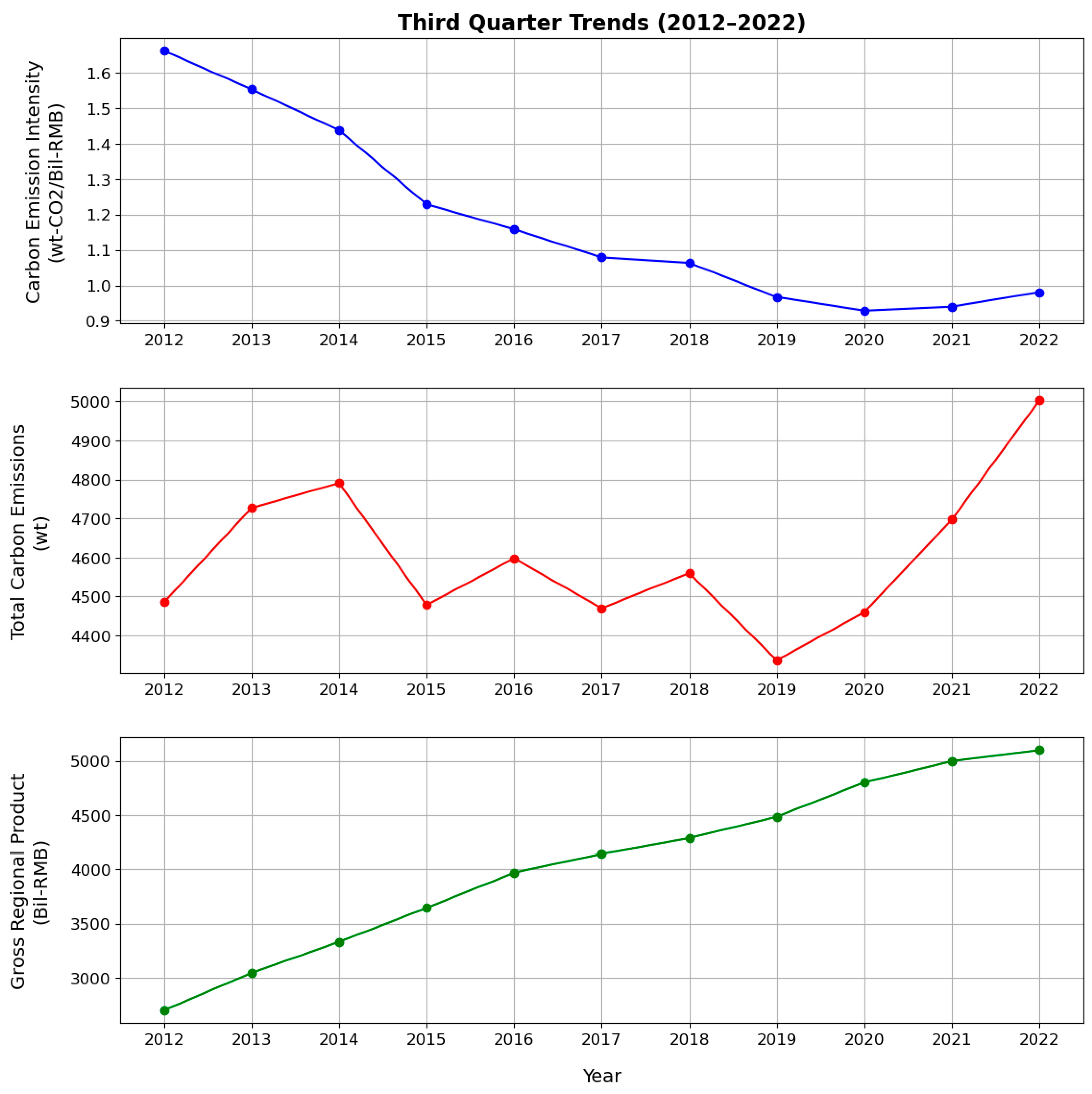
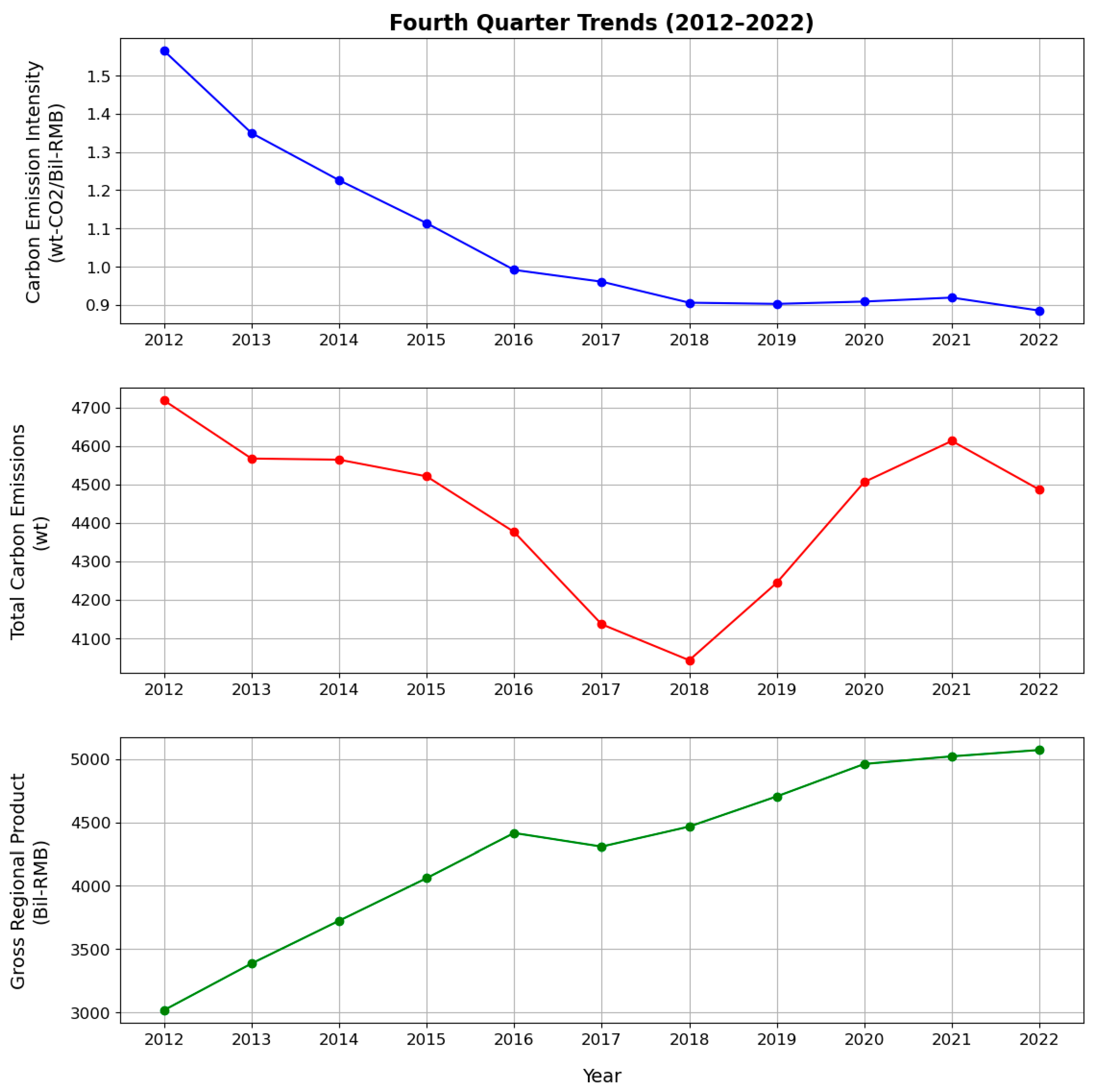
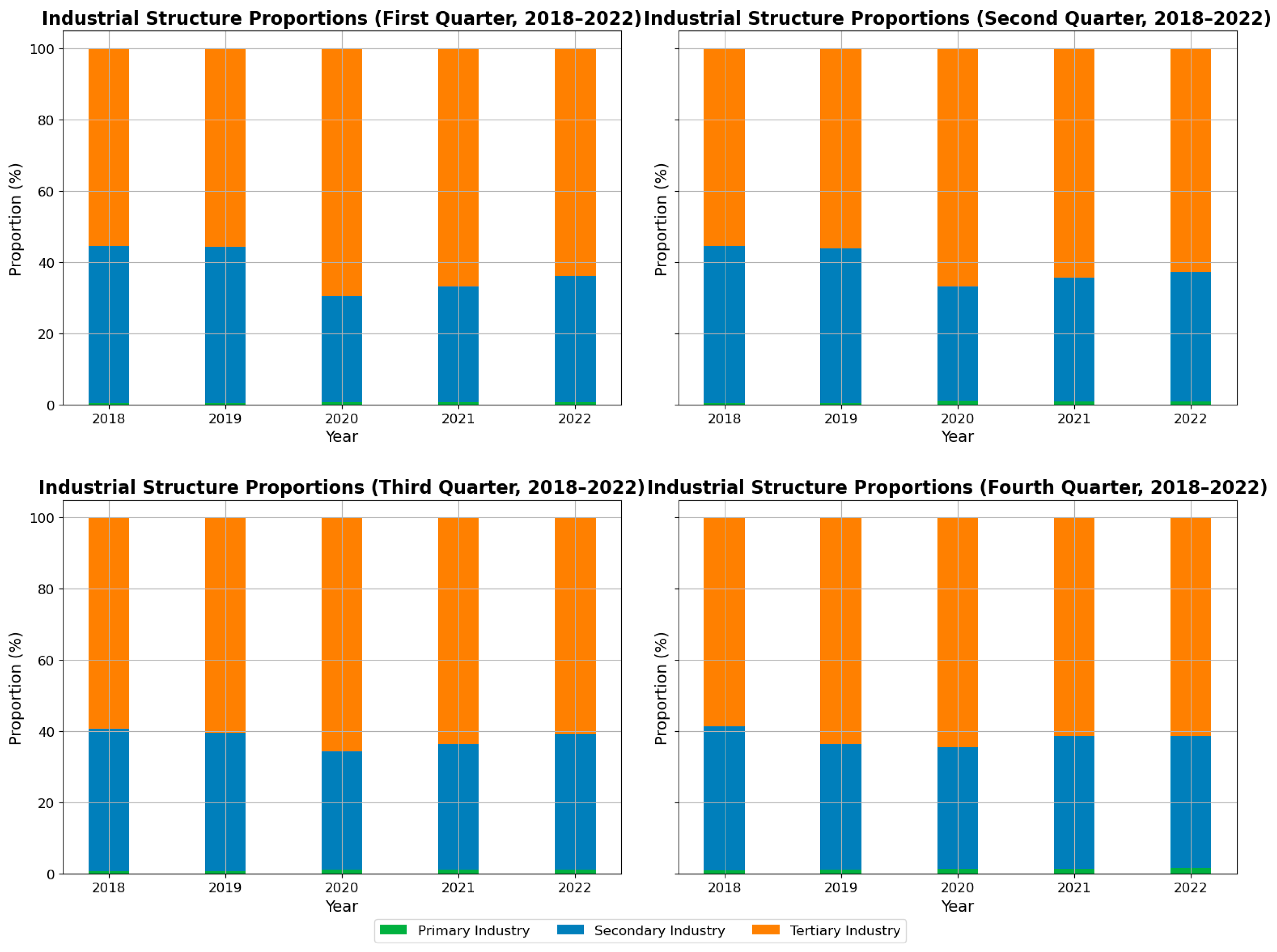
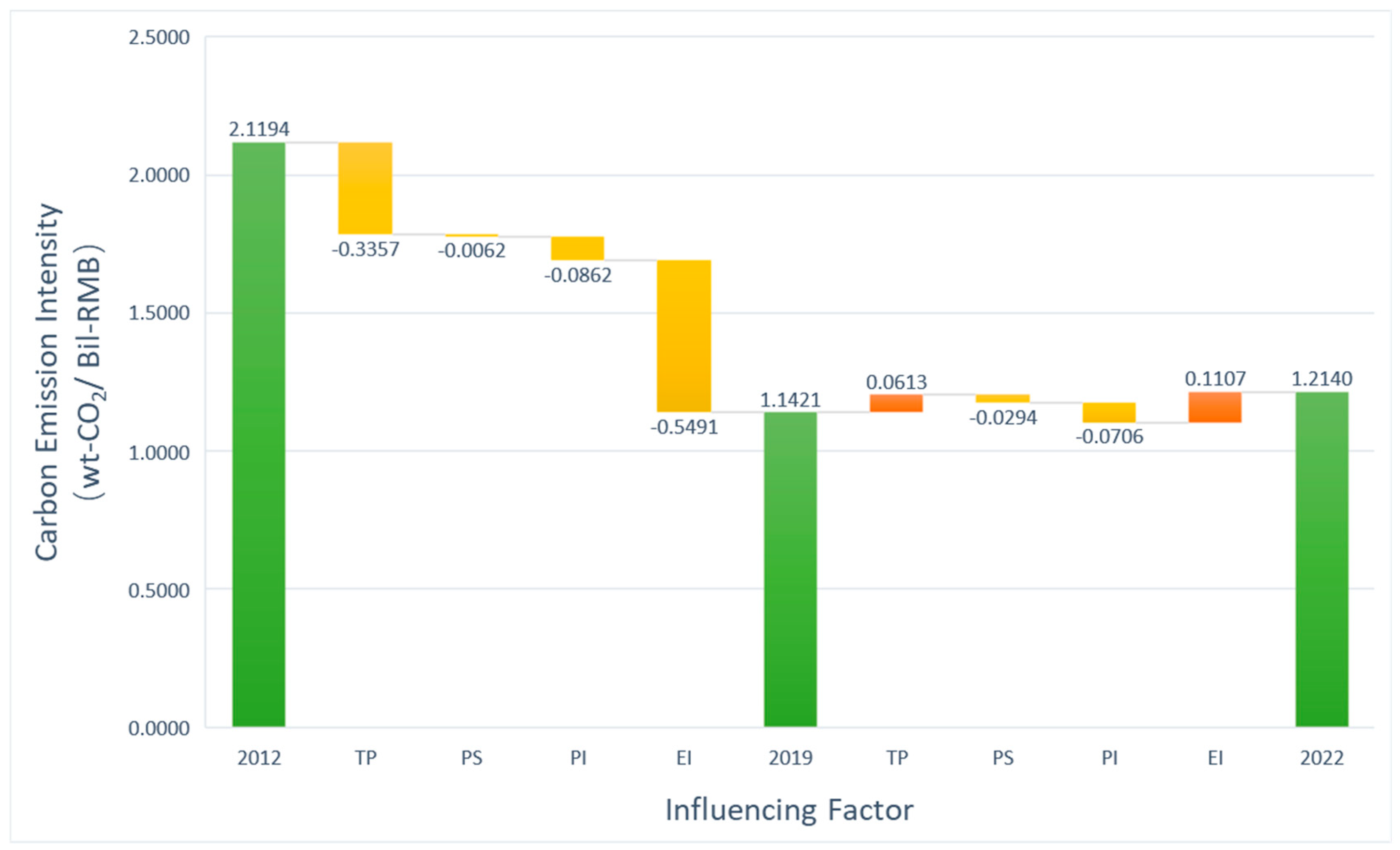
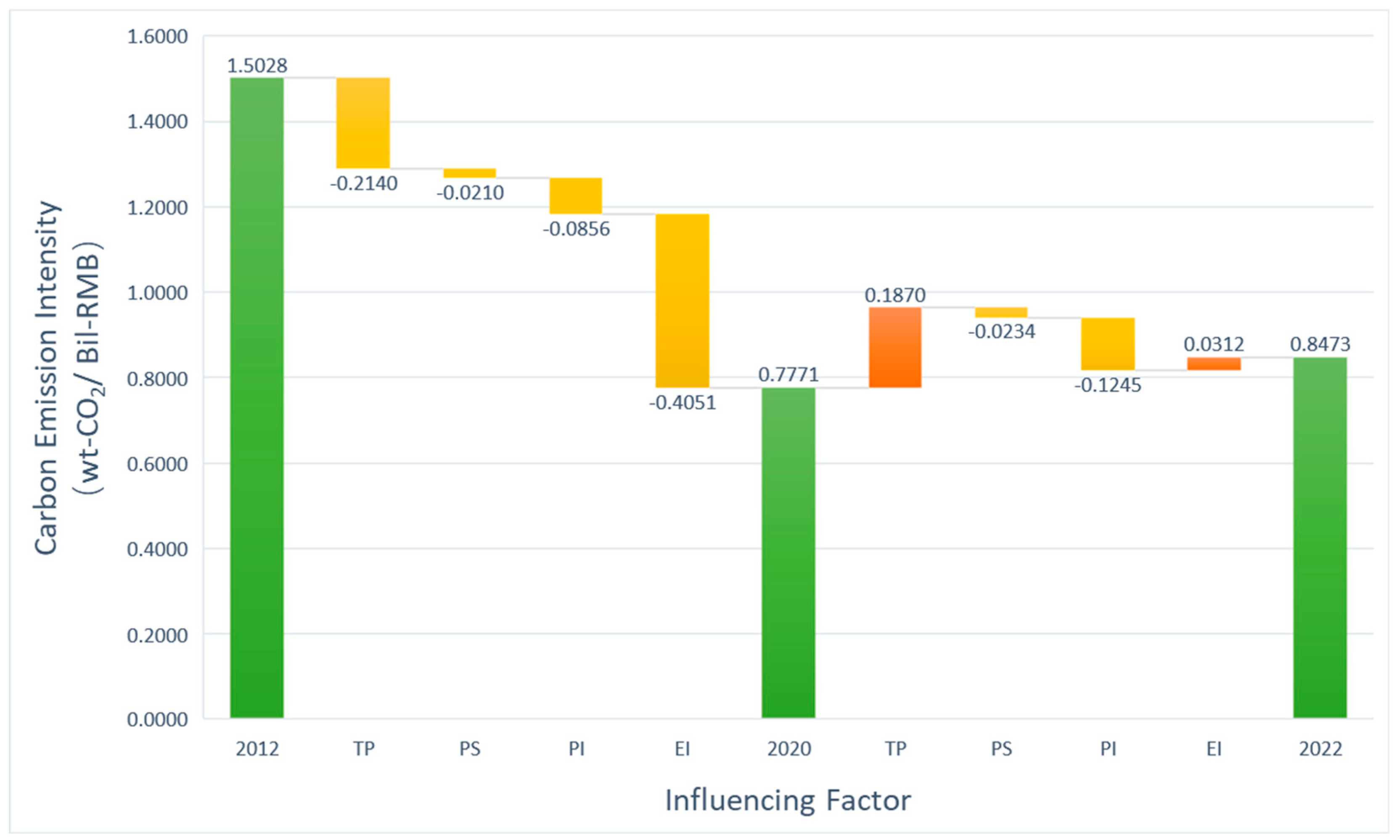
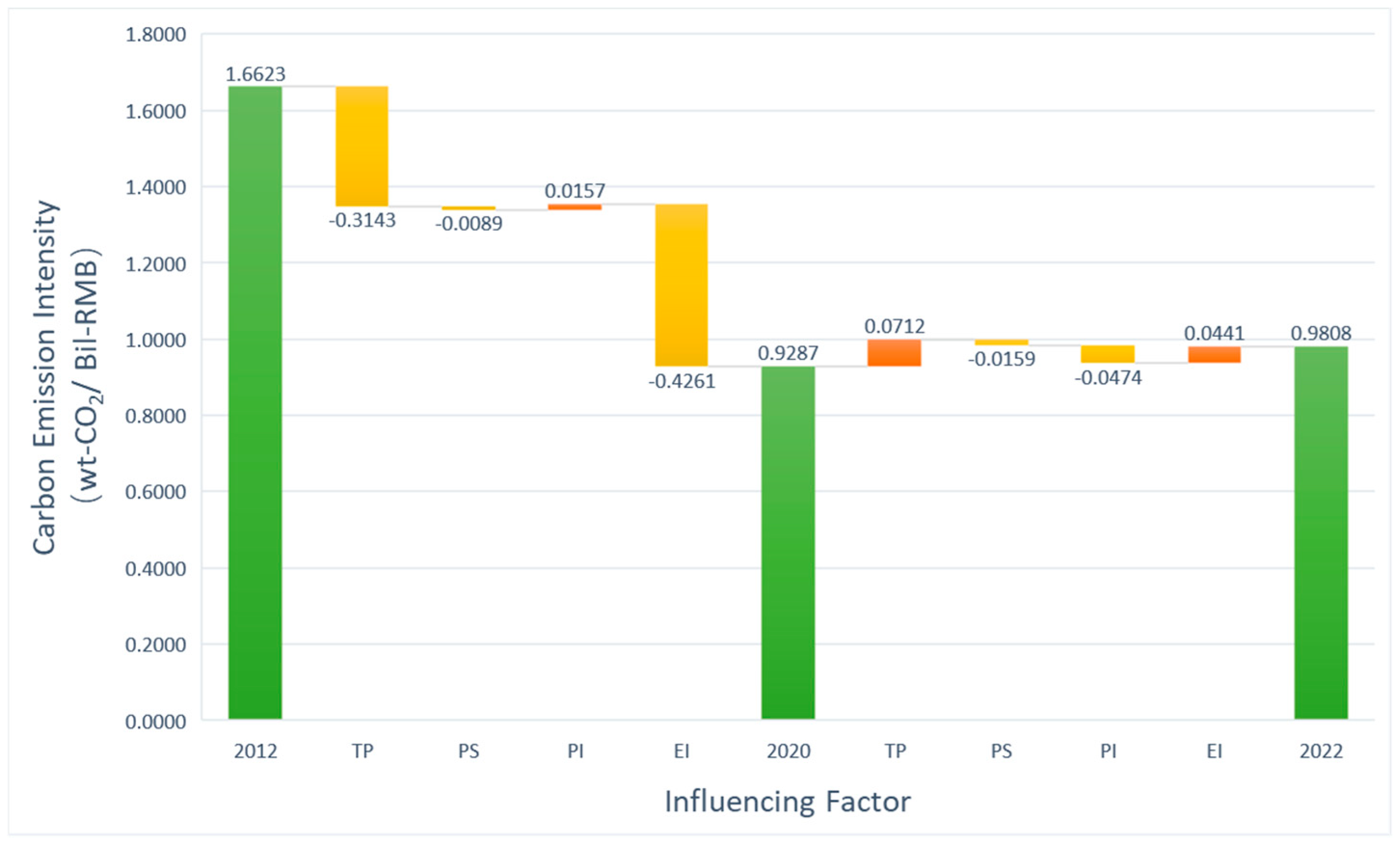
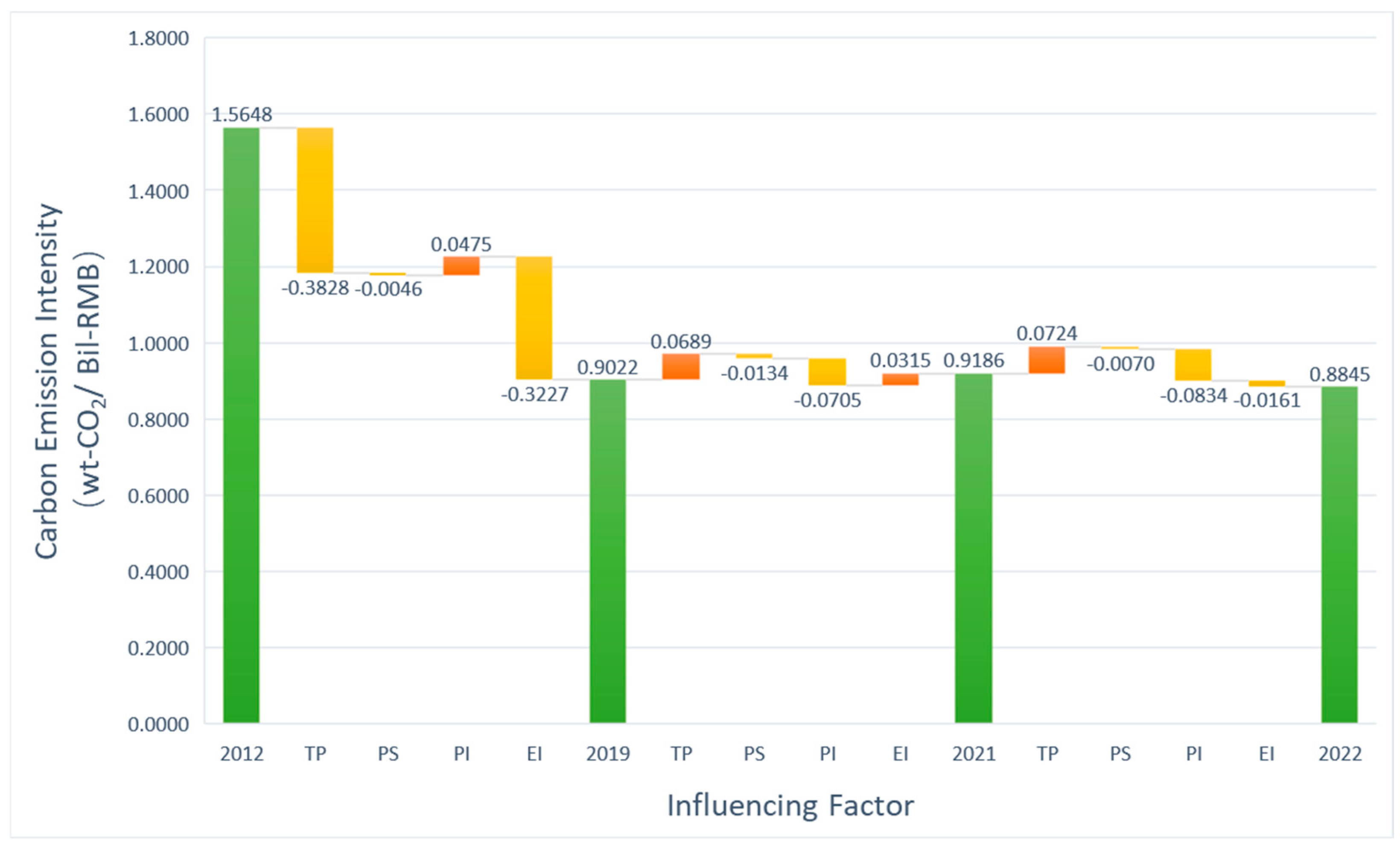
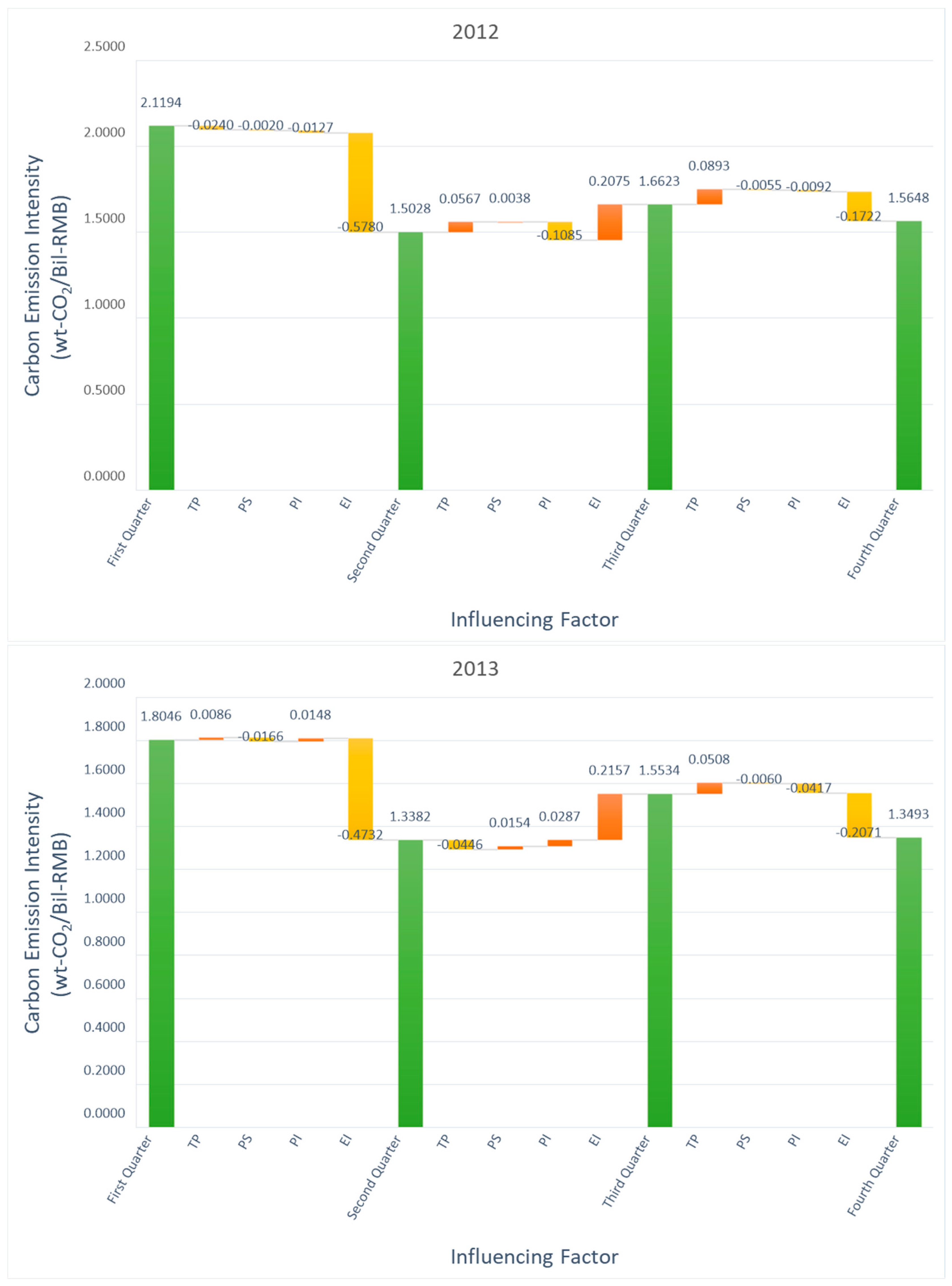
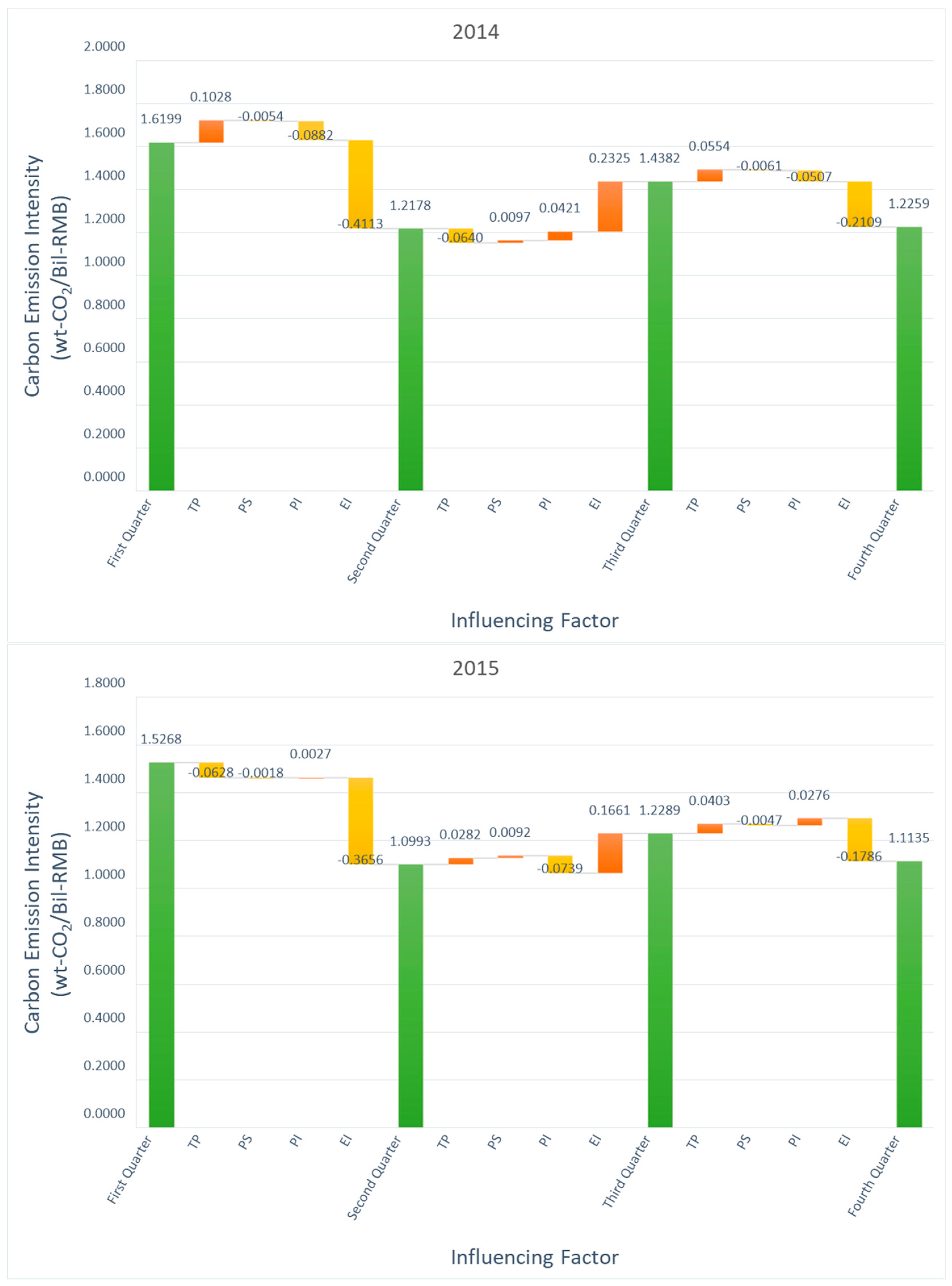
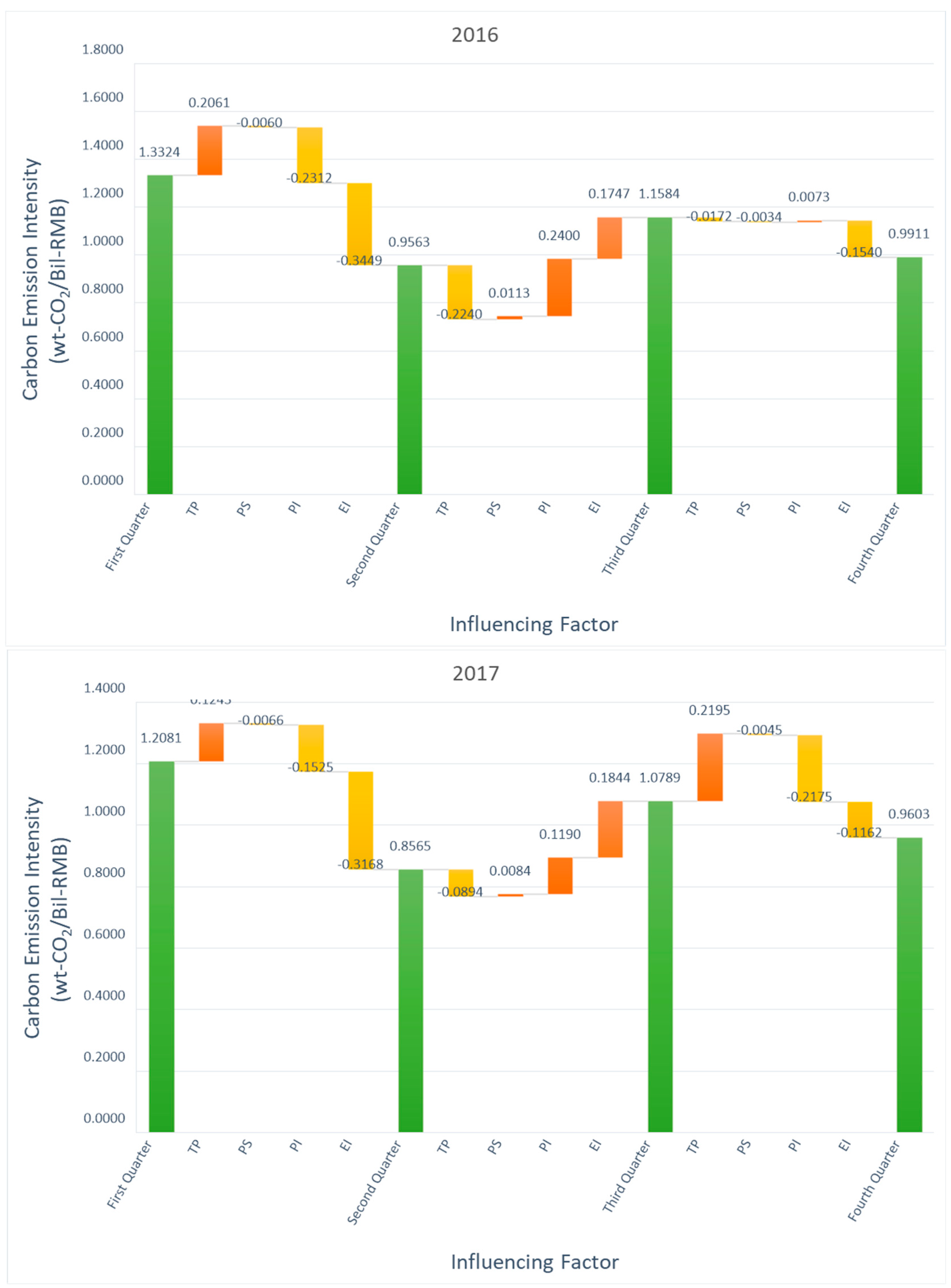
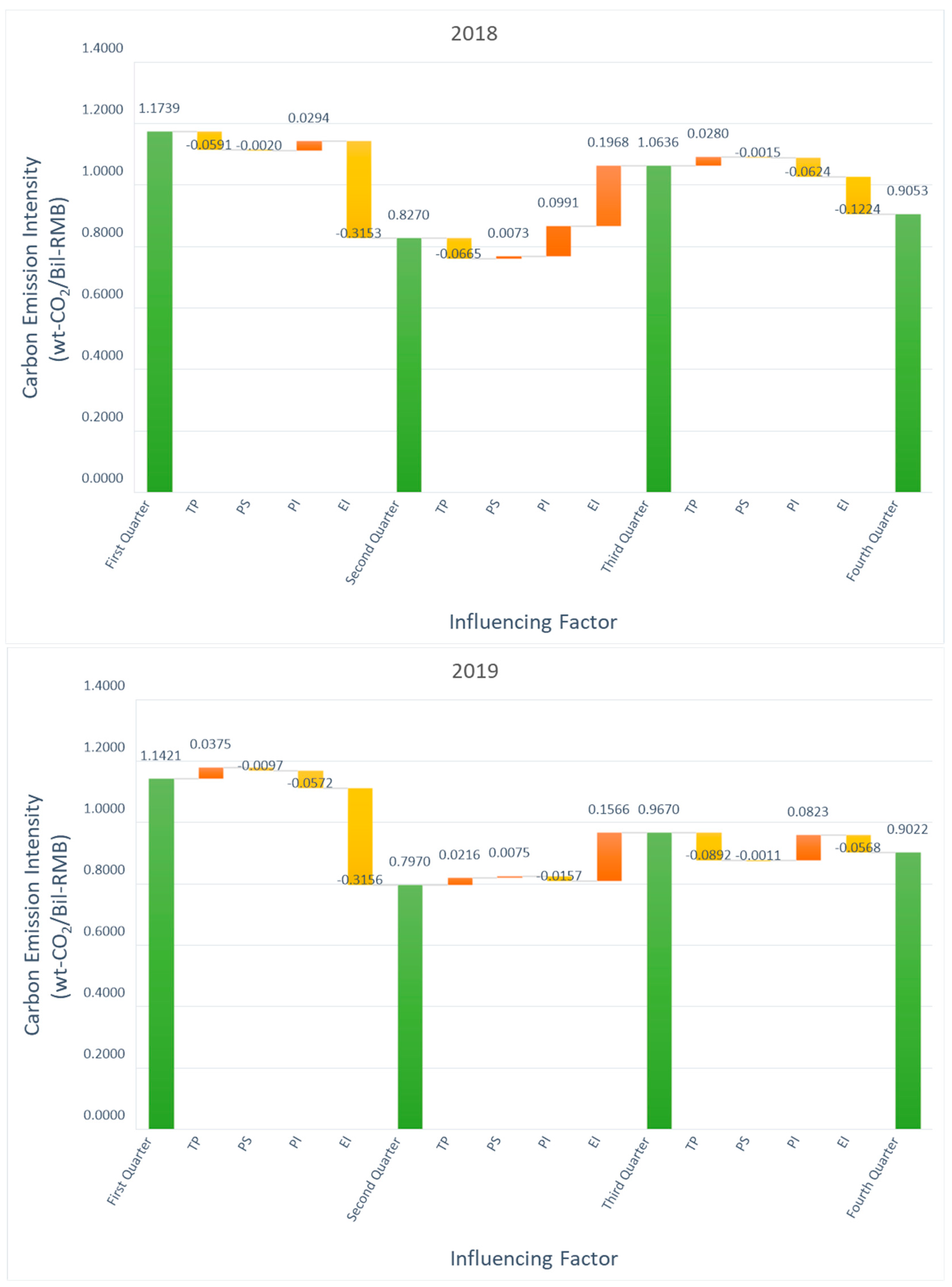
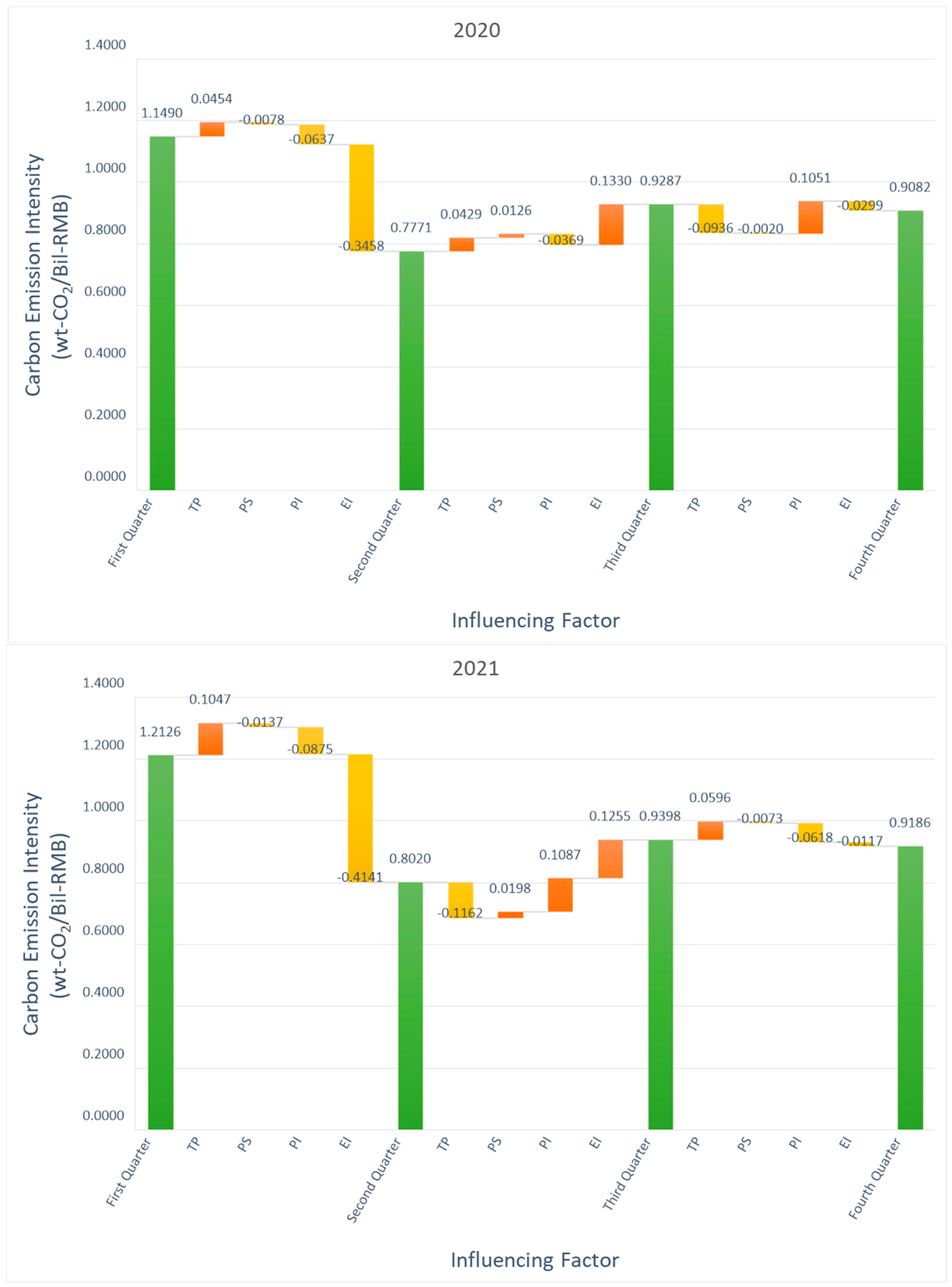
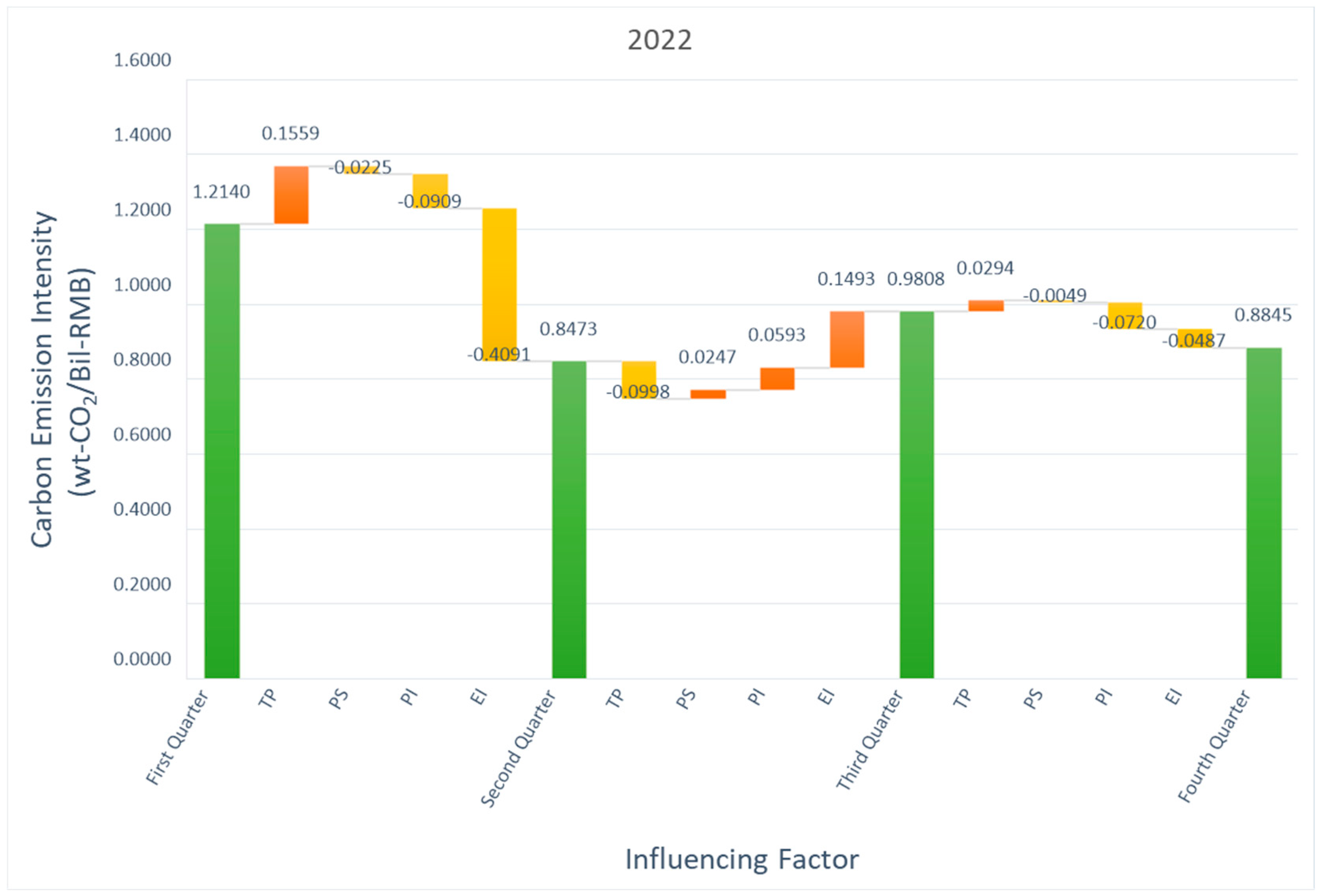
| Influencing Factor | Code | Factor | Description |
|---|---|---|---|
| Thermal Power Emission Effect | TP | Reflects the amount of carbon emissions per unit of electricity generated by thermal power. It measures the carbon emission efficiency of the thermal power generation process, indicating the impact of the technology and fuel type used in thermal power on carbon emissions. An improvement in this value indicates enhanced carbon efficiency in thermal power generation. | |
| Power Source Structure Effect | PS | Measures the proportion of thermal power in the total power generation. It reflects the impact of the energy structure on carbon emissions, particularly the share of thermal power (primarily coal, natural gas, and other fossil fuels) in the energy mix. A decrease in this proportion suggests an increased share of non-fossil sources (such as hydro, wind, or solar) in total power generation, aiding in reductions in carbon intensity. | |
| Power Intensity Effect | PI | Reflects the efficiency of the power supply system, i.e., the total power generation required per unit of electricity consumed. It can indicate power grid losses and the efficiency of the power system. A reduction in this value denotes improved power system efficiency, with reduced electricity loss during transmission and distribution, thereby aiding in carbon reduction. | |
| Economic Intensity Effect | EI | Measures the amount of electricity consumed per unit of GDP produced, reflecting the energy efficiency of economic activities. A decline in this value indicates that the growth in electricity consumption is slowing relative to economic growth, suggesting a shift towards a low-carbon, high-efficiency economic model. |
Disclaimer/Publisher’s Note: The statements, opinions and data contained in all publications are solely those of the individual author(s) and contributor(s) and not of MDPI and/or the editor(s). MDPI and/or the editor(s) disclaim responsibility for any injury to people or property resulting from any ideas, methods, instructions or products referred to in the content. |
© 2024 by the authors. Licensee MDPI, Basel, Switzerland. This article is an open access article distributed under the terms and conditions of the Creative Commons Attribution (CC BY) license (https://creativecommons.org/licenses/by/4.0/).
Share and Cite
Xiang, T.; Bian, J.; Li, Y.; Gu, Y.; Wang, Y.; Zhang, Y.; Wang, J. Seasonal Contributions and Influencing Factors of Urban Carbon Emission Intensity: A Case Study of Tianjin, China. Atmosphere 2024, 15, 947. https://doi.org/10.3390/atmos15080947
Xiang T, Bian J, Li Y, Gu Y, Wang Y, Zhang Y, Wang J. Seasonal Contributions and Influencing Factors of Urban Carbon Emission Intensity: A Case Study of Tianjin, China. Atmosphere. 2024; 15(8):947. https://doi.org/10.3390/atmos15080947
Chicago/Turabian StyleXiang, Tianchun, Jiang Bian, Yumeng Li, Yiming Gu, Yang Wang, Yahui Zhang, and Junfeng Wang. 2024. "Seasonal Contributions and Influencing Factors of Urban Carbon Emission Intensity: A Case Study of Tianjin, China" Atmosphere 15, no. 8: 947. https://doi.org/10.3390/atmos15080947
APA StyleXiang, T., Bian, J., Li, Y., Gu, Y., Wang, Y., Zhang, Y., & Wang, J. (2024). Seasonal Contributions and Influencing Factors of Urban Carbon Emission Intensity: A Case Study of Tianjin, China. Atmosphere, 15(8), 947. https://doi.org/10.3390/atmos15080947






